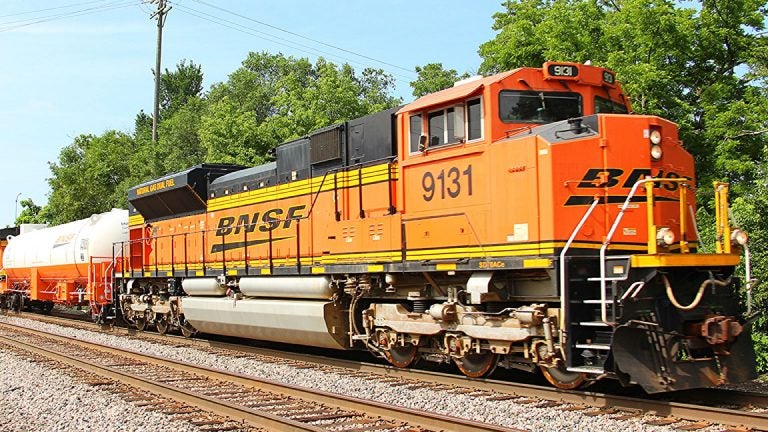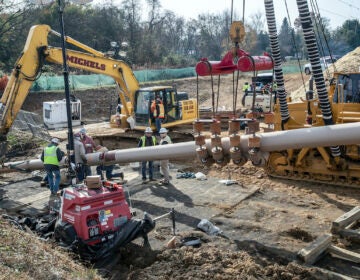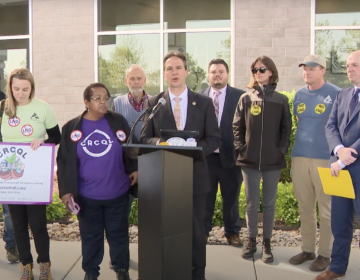Feds approve plan to ship liquefied natural gas to South Jersey by rail
Environmental groups say cargoes would risk public safety, set back climate efforts.

LNG units on the BNSF Emporia Sub in Olathe, Kansas (NJ Spotlight)
This article originally appeared on NJ Spotlight.
—
Plans to build New Jersey’s first liquefied natural gas terminal moved forward when federal regulators approved the use of trains to ship the fuel to Gibbstown on the Delaware River from Wyalusing in northeastern Pennsylvania — the first route in the nation where transportation of LNG by rail would be allowed.
The U.S. Pipeline and Hazardous Materials Safety Administration published its approval on Friday of the plan by Energy Transport Solutions, a logistics subsidiary of New Fortress Energy, which wants to liquefy natural gas from the abundant reserves in Pennsylvania’s Marcellus Shale, and export it via a yet-to-be-built terminal at Gibbstown in Gloucester County.
The idea of carrying the super-cooled natural gas by train about 175 miles to South Jersey was an unexpected development after earlier plans to use at least 360 truck trips a day. It is unclear whether trains would substitute for trucks or will be in addition to them.
The pipeline regulator said it was satisfied that Energy Transport Solutions could safely operate the trains despite protests by environmental groups that the highly explosive liquids carried in them represent a grave risk to public safety, especially if they travel through densely populated areas like Philadelphia or Camden.
“PHMSA’s technical evaluators have determined that the special permit provides an equivalent level of safety to what is required under the Hazardous Materials Regulations, and recommend that the permit be granted,” the agency said in a statement.
It authorized a special permit for shipments only between the two points, in a specific type of tank car; directed the applicant to submit its plans for the quantities of LNG to be shipped, and their timing, within 90 days, and said it must prepare local emergency responders to deal with any incident involving the release of LNG. The company must comply with the conditions within an estimated 6-12-month period before the shipments begin.
Fueling fears of more shipments
And in an instruction that will fuel critics’ fears of a growing volume of shipments, the agency ordered the company to say how it will handle an expected increase in the volume of LNG by rail.
“It is anticipated that under the special permit the grantee will transition from moving rail tank cars as part of a larger train to moving unit trains (20 or more cars) of LNG,” PHMSA said.
The approval increases the chances that the project will be built over the strenuous objections of environmentalists who, in addition to safety fears, argue that regulators should not be approving new fossil fuel projects at a time when authorities at many levels — with the exception of the federal government — are setting ambitious goals to cut carbon emissions and curb climate change.
PHMSA’s approval follows an Executive Order by President Donald Trump in April calling for new regulations that would for the first time allow the transportation of LNG by rail, to bring it in line with other flammable super-cooled liquids such as ethylene.
In October, PHMSA proposed a “major rule” that would allow trains to carry LNG, saying that the change would boost the availability and competitiveness of domestic natural gas supplies on the world market.
“Transportation of LNG by rail is a potentially viable alternative to pipelines, which are not always able to meet the demand of, or reach, certain areas in the U.S. that are accessible by rail,” the agency said then.
The United States began exporting liquefied natural gas in early 2016 in response to a surge in domestic production caused by hydraulic fracking of shale reserves, including those in Pennsylvania. Most export terminals are on the Gulf Coast, but they also include one at Cove Point in Maryland.
Train or truck?
PHMSA said it received about 2,000 public comments in an Environmental Assessment of its plans to allow LNG to be carried by rail. Those comments were reviewed by Exponent, an engineering firm that was hired by PHMSA.
The firm concluded that transport of LNG by rail would be safer than by truck because a single train can carry the same volume as multiple truck trips. For example, it would take 300 trucks to carry the 3 million gallons of LNG that would be transported by a single unit train, the firm concluded.
Spokespeople for New Fortress Energy did not immediately respond to a request for comment.
Empower NJ, a coalition of about 90 environmental and progressive groups that is pressing Gov. Phil Murphy to block all fossil fuel expansion, said eastern Pennsylvania and South Jersey where the trains are due to run are being used as “guinea pigs” for the industry to prove that the trains are safe.
“New Fortress Energy’s speculative project to export LNG from the shale fields of Pennsylvania to the Delaware River and then overseas for sale is turning the proposed project’s footprint into a sacrifice zone, since it is the only place in the nation where it will be allowed,” the group said.
It called the proposed LNG trains “bomb trains,” similar to the language critics used to describe crude oil trains that previously rolled through central Philadelphia a few years ago on their way to the now-shuttered South Philadelphia Refinery.
The proposed LNG terminal at Gibbstown represents an expansion of a plan to build a dock on a former DuPont site there. It still needs permits from regulators including the New Jersey Department of Environmental Protection and the Delaware River Basin Commission.
WHYY is your source for fact-based, in-depth journalism and information. As a nonprofit organization, we rely on financial support from readers like you. Please give today.




